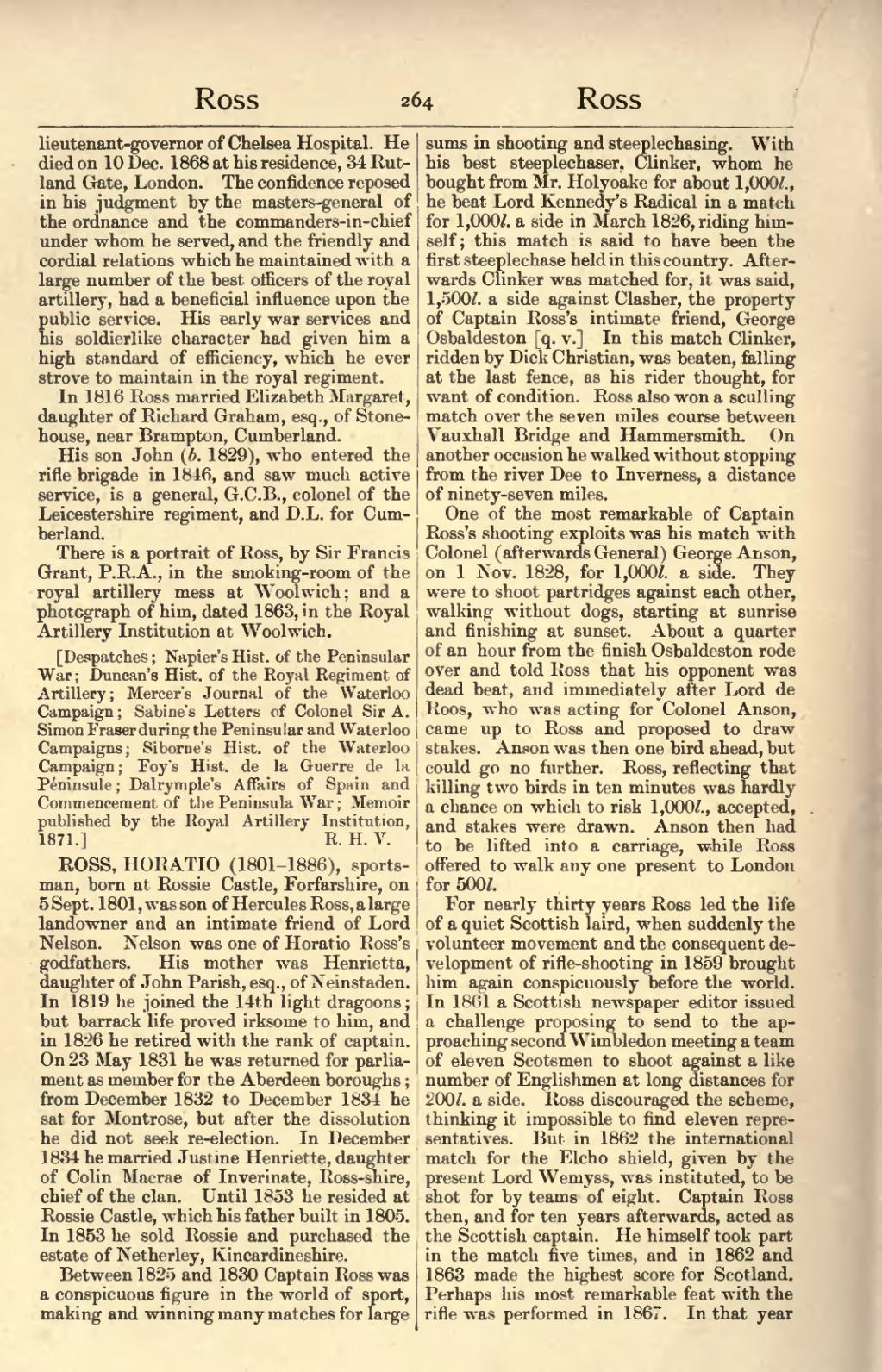lieutenant-governor of Chelsea Hospital. He died on 10 Dec. 1868 at his residence, 34 Rutland Gate, London. The confidence reposed in his judgment by the masters-general of the ordnance and the commanders-in-chief under whom he served, and the friendly and cordial relations which he maintained with a large number of the best officers of the royal artillery, had a beneficial influence upon the public service. His early war services and his soldierlike character had given him a high standard of efficiency, which he ever strove to maintain in the royal regiment.
In 1816 Ross married Elizabeth Margaret, daughter of Richard Graham, esq., of Stonehouse, near Brampton, Cumberland.
His son John (b. 1829), who entered the rifle brigade in 1846, and saw much active service, is a general, G.C.B., colonel of the Leicestershire regiment, and D.L. for Cumberland.
There is a portrait of Ross, by Sir Francis Grant, P.R.A., in the smoking-room of the royal artillery mess at Woolwich; and a photograph of him, dated 1863, in the Royal Artillery Institution at Woolwich.
[Despatches; Napier's Hist. of the Peninsular War; Duncan's Hist. of the Royal Regiment of Artillery; Mercer's Journal of the Waterloo Campaign; Sabine's Letters of Colonel Sir A. Simon Fraser during the Peninsular and Waterloo Campaigns; Siborne's Hist. of the Waterloo Campaign; Foy's Hist. de la Guerre de la Péninsule; Dalrymple's Affairs of Spain and Commencement of the Peninsula War; Memoir published by the Royal Artillery Institution, 1871.]
ROSS, HORATIO (1801–1886), sportsman, born at Rossie Castle, Forfarshire, on 5 Sept. 1801, was son of Hercules Ross, a large landowner and an intimate friend of Lord Nelson. Nelson was one of Horatio Ross's godfathers. His mother was Henrietta, daughter of John Parish, esq., of Neinstaden. In 1819 he joined the 14th light dragoons; but barrack life proved irksome to him, and in 1826 he retired with the rank of captain. On 23 May 1831 he was returned for parliament as member for the Aberdeen boroughs; from December 1832 to December 1834 he sat for Montrose, but after the dissolution he did not seek re-election. In December 1834 he married Justine Henriette, daughter of Colin Macrae of Inverinate, Ross-shire, chief of the clan. Until 1853 he resided at Rossie Castle, which his father built in 1805. In 1853 he sold Rossie and purchased the estate of Netherley, Kincardineshire.
Between 1825 and 1830 Captain Ross was a conspicuous figure in the world of sport, making and winning many matches for large sums in shooting and steeplechasing. With his best steeplechaser, Clinker, whom he bought from Mr. Holyoake for about 1,000l., he beat Lord Kennedy's Radical in a match for 1,000l. a side in March 1826, riding himself; this match is said to have been the first steeplechase held in this country. Afterwards Clinker was matched for, it was said, 1,500l. a side against Clasher, the property of Captain Ross's intimate friend, George Osbaldeston [q. v.] In this match Clinker, ridden by Dick Christian, was beaten, falling at the last fence, as his rider thought, for want of condition. Ross also won a sculling match over the seven miles course between Vauxhall Bridge and Hammersmith. On another occasion he walked without stopping from the river Dee to Inverness, a distance of ninety-seven miles.
One of the most remarkable of Captain Ross's shooting exploits was his match with Colonel (afterwards General) George Anson, on 1 Nov. 1828, for 1,000l. a side. They were to shoot partridges against each other, walking without dogs, starting at sunrise and finishing at sunset. About a quarter of an hour from the finish Osbaldeston rode over and told Ross that his opponent was dead beat, and immediately after Lord de Roos, who was acting for Colonel Anson, came up to Ross and proposed to draw stakes. Anson was then one bird ahead, but could go no further. Ross, reflecting that killing two birds in ten minutes was hardly a chance on which to risk 1,000l., accepted, and stakes were drawn. Anson then had to be lifted into a carriage, while Ross offered to walk any one present to London for 500l.
For nearly thirty years Ross led the life of a quiet Scottish laird, when suddenly the volunteer movement and the consequent development of rifle-shooting in 1859 brought him again conspicuously before the world. In 1861 a Scottish newspaper editor issued a challenge proposing to send to the approaching second Wimbledon meeting a team of eleven Scotsmen to shoot against a like number of Englishmen at long distances for 200l. a side. Ross discouraged the scheme, thinking it impossible to find eleven representatives. But in 1862 the international match for the Elcho shield, given by the present Lord Wemyss, was instituted, to be shot for by teams of eight. Captain Ross then, and for ten years afterwards, acted as the Scottish captain. He himself took part in the match five times, and in 1862 and 1863 made the highest score for Scotland. Perhaps his most remarkable feat with the rifle was performed in 1867. In that year
